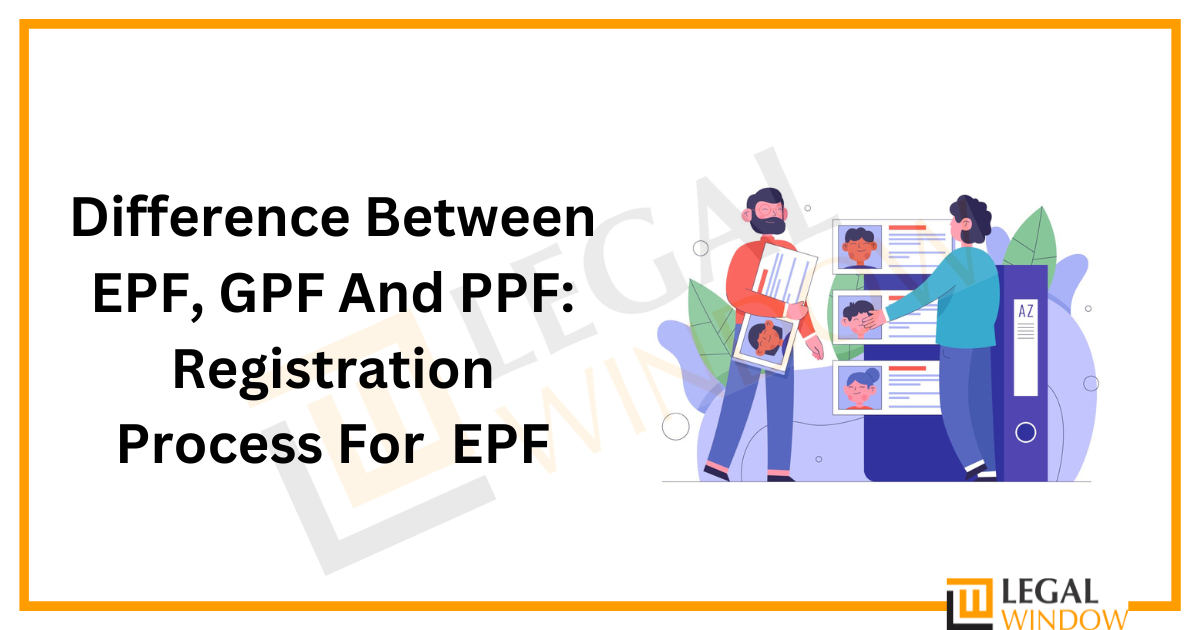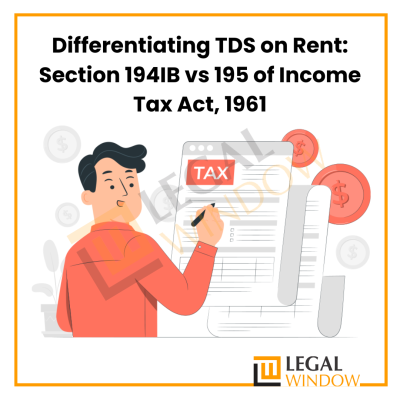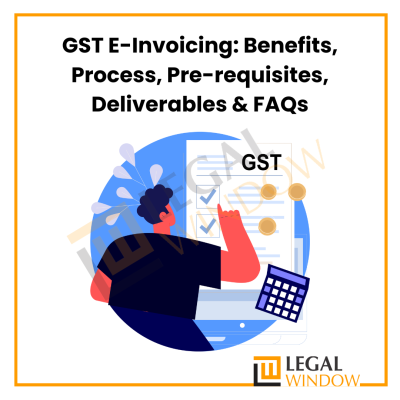Difference Between EPF, GPF And PPF: Registration Process For EPF
- July 21, 2023
- Miscellaneous

Employees Provident Fund, General Provident Fund, and Public Provident Fund are all savings schemes offered by the Indian government to help citizens save money for their future. In this essay, we will understand EPF, GPF, And PPF and the registration process for EPF.
Employees Provident Fund (EPF)
Employees Provident Fund (EPF) is a retirement savings scheme available to all employees in India who earn a salary of up to INR 15,000 per month. The contribution to the EPF is shared by the employer and the employee, with each contributing 12% of the employee’s
basic salary and dearness allowance to the collective fund. The EPF provides a lump sum pay-out to the employee upon retirement and may also be withdrawn in certain circumstances, such as marriage, education, or medical emergencies.
General Provident Fund (GPF)
General Provident Fund (GPF) is a savings scheme available to government employees in India. The scheme is voluntary and allows employees to contribute a portion of their salary towards their retirement savings. The government matches the employee’s contribution, and
manages the funds until the employee’s retirement. GPF is a popular option for government employees because it offers tax benefits and allows employees to borrow against their savings if needed.
Public Provident Fund (PPF)
Public Provident Fund (PPF) is a savings scheme available to all Indian citizens. The scheme is a long-term investment with a minimum tenure of 15 years and offers tax benefits. The PPF provides a fixed rate of interest, currently at 7.1%, which is compounded annually. The scheme also allows for partial withdrawals and early closure of the account in certain circumstances, such as medical emergencies.
EPF, GPF & PPF An Analysis
All three schemes are important instruments for retirement planning and saving in India. They provide a guaranteed return on investment and have tax benefits that make them attractive to individuals looking to save money for the future. The EPF and GPF are compulsory for certain employees, whereas the PPF is voluntary.
Different government bodies regulate the EPF, GPF, and PPF. The EPF is managed by the Employees Provident Fund Organization (EPFO), which the Ministry of Labour and Employment oversees. The respective state governments manage the GPF for employees
working in the government sector, whereas the PPF, the Ministry of Finance, manages the PPF-designated banks and post offices.
Despite their many advantages, the schemes have certain limitations. For instance, the maximum contribution to the EPF is limited to INR 1.5 lakhs annually. Similarly, the maximum amount that can be deposited in the PPF account is also limited to INR 1.5 lakhs
annually. Moreover, the interest rate for these schemes may be revised periodically, which could impact the returns on investment.
What are the Major Differences Between EPF, GPF & PPF?
The major differences between Employees Provident Fund, General Provident Fund, and Public Provident Fund are as follows:
- Purpose: Employees Provident Fund (EPF) is a mandatory retirement savings scheme for employees in India, while General Provident Fund (GPF) is a voluntary fund for government employees. Public Provident Fund (PPF) is a long-term investment option for individuals.
- Eligibility: EPF is applicable to employees working in organized sectors, while GPF is applicable only to government employees. PPF is open to all Indian citizens.
- Contribution: In EPF, both the employee and employer contribute 12% of the employee’s basic salary towards the scheme. In GPF, the employee contributes a minimum of 6% of their salary, while the employer matches the contribution. In PPF, the maximum annual contribution limit is Rs. 1.5 lakh, and the investor can make contributions in a lump sum or in instalments.
- Interest Rate: The government declares the interest rates for EPF and GPF and are subject to change periodically. Currently, the interest rate for EPF is 8.5% per annum, while the interest rate for GPF is 7.1% per annum. For PPF, the government reviews the interest rate quarterly and is currently at 7.1% per annum.
- Withdrawal: EPF can be withdrawn at the time of retirement, resignation, or in case of any emergency as specified by the government. GPF can be withdrawn partially or fully at different stages of the employee’s career or at the time of retirement. PPF has a lock-in period of 15 years, but partial withdrawals are allowed from the seventh year onwards.
- Taxation: EPF and GPF require no tax payment on the contributions made by the employee or the employer. However, the interest earned on EPF is taxable if withdrawn before five years. Interest earned on PPF is tax-free, and the contribution made towards PPF is tax-deductible under Section 80C of the Income Tax Act.
| Criteria | EPF | GPF | PPF |
|---|---|---|---|
| Purpose | Savings for employees in the private sector | Savings for government employees | Savings for individuals, including self-employed and employees in the public and private sectors |
| Eligibility | Employees in the organized private sector | Government employees | Indian citizens aged 18 and above |
| Registration Process for EPF | 1. Employer should obtain an establishment code from the EPFO.
2. The employer must register the establishment on the EPFO portal by submitting relevant information such as name, address, type of industry, number of employees, etc. 3. Once registered, the employer will receive a unique employer ID. 4. Employees need to provide their KYC (Know Your Customer) documents to the employer. 5. The employer will create an employee account under the EPF scheme and link it to the employee’s Aadhaar card and bank account. |
Not applicable | Not applicable |
| Contributions | Both the employee and employer contribute 12% of basic wages plus dearness allowance to the EPF account. The employer also contributes 8.33% of the employer’s share towards the Employee Pension Scheme (EPS). | Both the employee and employer contribute a certain percentage of the basic pay to the GPF account. The percentage may vary depending on the government’s rules and regulations. | Individuals can contribute a minimum of Rs. 500 per year and a maximum of Rs. 1.5 lakh per year to the PPF account. |
| Interest Rate | The interest rate is determined by the government and is revised annually. For the financial year 2020-21, EPF interest rate is 8.5%. | The interest rate is determined by the government and is revised annually. It is generally higher than EPF. | The interest rate is determined by the government and is revised quarterly. For the current quarter, PPF interest rate is 7.1%. |
| Withdrawal Rules | Partial withdrawals allowed for specified purposes such as education, marriage, medical emergencies, etc. Full withdrawal allowed upon retirement, resignation, or after a certain period. | Partial withdrawals allowed for specified purposes such as education, marriage, medical emergencies, etc. Full withdrawal allowed upon retirement. | Partial withdrawals allowed after the 7th year. The account can be closed after 15 years but can be extended in blocks of 5 years. |
| Tax Benefits | Tax exemption on the employee’s contributions and the interest earned. Employer’s contributions are also tax-deductible. | Tax exemption on the employee’s contributions and the interest earned. Employer’s contributions are also tax-deductible. | Tax exemption on contributions, interest earned, and withdrawals. |
What are the Documents Required for EPF, GPF &, PPF?
Employees Provident Fund (EPF):
- Permanent Account Number (PAN) card.
- Aadhaar card.
- Bank account details.
- Employee details such as name, date of birth, and address.
- Employer details such as name and address.
- Employee Provident Fund (EPF) account number.
- Form 11 (Declaration Form for EPF).
- Form 2 (Nomination Form).
General Provident Fund (GPF):
- Employee’s GPF account number.
- Pay details of the employee.
- Employee’s address.
- Employee’s nomination details
- GPF subscription details.
- GPF Advance/Withdrawal Form.
- Form 6A (Application for Final Payment/Transfer of Balances in GPF).
Public Provident Fund (PPF):
- Permanent Account Number (PAN) card.
- Aadhaar card.
- Bank account details.
- Employee details such as name, date of birth, and address.
- Form A (Account Opening Form).
- Nomination form.
- Passbook or statement of account in case of an existing account.
- Deposit slip for PPF contribution.
- Form C for partial withdrawal or loan against PPF balance.
Note: The required documents may vary depending on the specific requirements of each
provident fund scheme. Checking with the concerned authority or employer for a
comprehensive list of required documents is advisable.
Advantages of EPF
- Guaranteed returns: EPF offers one of the safest and most reliable investment options with a guaranteed interest rate on contributions made.
- Tax benefits: The employee and employer contributions made towards EPF are eligible for tax deduction under Section 80C of the Income Tax Act.
- Retirement savings: EPF builds a corpus for an employee to use as a post-retirement fund for their basic needs and expenses.
- Insurance cover: In case of the death of the employee, EPF provides life insurance cover for the employee’s family members.
- Loan facility: Members of the EPF can avail of loans and advances against their EPF accounts for specific purposes such as house construction, education, medical treatment, etc.
Advantages of GPF
- Guaranteed returns: GPF offers a guaranteed rate of interest on the contributions made, reducing the risk of loss of capital.
- Retirement savings: GPF allows an individual to save for their post-retirement expenses, making it a beneficial savings platform.
- Tax benefits: Contributions to GPF are eligible for tax deductions under Section 80C of the Income Tax Act. Loan facility: Members of the PPF can avail of loans and advances against their PPF accounts for specific purposes such as house construction, education, medical treatment, etc.
Advantages of PPF
- Tax-free returns: The returns on investment in PPF are tax-free, which means the accumulated interest is not subject to taxation.
- Guaranteed returns: PPF offers a guaranteed rate of interest on the contributions made, reducing the risk of loss of capital.
- Retirement savings: PPF allows individuals to save for their post-retirement expenses, making it a beneficial savings platform.
- Loan facility: Members of the PPF can avail of loans and advances against their PPF accounts for specific purposes such as house construction, education, medical treatment, etc.
What is the Registration Process for the Employees Provident Fund (EPF)?
The registration for EPF is as follows:
- Eligibility: Any salaried employee who receives a monthly salary of Rs. 15,000 or less is eligible for EPF registration. However, employees can still opt for EPF registration even if their salary exceeds Rs. 15,000.EPF contributions:
- Documents Required Registration Process For EPF: Employers need to provide the following documents to register their employees for EPF:
- PAN Card
- Aadhar Card
- Address Proof
- Bank Account details
- Salary details
- KYC Documents
- Employee details like name, date of birth, etc.
- Online Registration: Employers can register their employees online on the EPF website. They need to visit the EPF portal and register themselves first. After registration, they can log in with their credentials and register their employees.
- Generation of UAN: After successful registration, a unique Universal Account Number (UAN) is generated for each employee. This number should be shared with the employee for further PF contributions.
- EPF contributions: Employers are required to contribute 12% of the employee’s basic salary and dearness allowance towards the EPF scheme. The employee also contributes an equal amount.
- Monthly Filing: Employers are required to file the monthly EPF returns. These returns should showcase the details of contributions made and the number of employees registered under the scheme.
- Compliance: Employers must ensure that they comply with the EPF regulations. They must pay their PF contributions regularly and also follow other rules and regulations laid down by the EPF department. Failing to comply with these regulations can attract penalties and legal action.
Conclusion
In conclusion, the Employees Provident Fund, General Provident Fund, and Public Provident Fund are all important savings schemes in India that are designed to encourage citizens to save for their future needs. These schemes offer guaranteed returns, tax benefits, and
flexibility in terms of withdrawals and loans. Therefore, individuals need to be aware of these schemes and choose the one that suits their financial goals and needs.
LegalWindow.in is a professional technology driven platform of multidisciplined experts like CA/CS/Lawyers spanning with an aim to provide concrete solution to individuals, start-ups and other business organisation by maximising their growth at an affordable cost. Our team offers expertise solutions in various fields that include Corporate Laws, Direct Taxations, GST Matters, IP Registrations and other Legal Affairs.
Categories
- Agreement Drafting (23)
- Annual Compliance (11)
- Change in Business (36)
- Company Law (148)
- Compliance (90)
- Digital Banking (3)
- Drug License (3)
- FEMA (17)
- Finance Company (42)
- Foreign Taxation (6)
- FSSAI License/Registration (14)
- GST (120)
- Hallmark Registration (1)
- Income Tax (202)
- Latest News (34)
- Miscellaneous (165)
- NBFC Registration (8)
- NGO (14)
- SEBI Registration (6)
- Section 8 Company (7)
- Start and manage a business (21)
- Startup/ Registration (130)
- Trademark Registration/IPR (40)
Recent Posts
About us
LegalWindow.in is a professional technology driven platform of multidisciplined experts like CA/CS/Lawyers spanning with an aim to provide concrete solution to individuals, start-ups and other business organisation by maximising their growth at an affordable cost.









